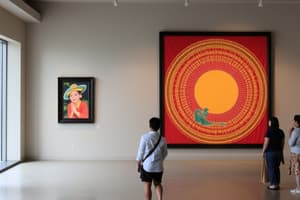Podcast
Questions and Answers
Which of the following factors played a significant role in the development of Philippine art during American rule?
Which of the following factors played a significant role in the development of Philippine art during American rule?
- Restricted education access
- Urbanization and consumerism (correct)
- Return to traditional practices
- Isolation from global influences
What is the significance of the Manunggul Jar in the context of Filipino art?
What is the significance of the Manunggul Jar in the context of Filipino art?
- It represents early agricultural practices.
- It illustrates the folk art traditions of the regions.
- It is a decorative piece with no spiritual significance.
- It signifies the belief in life after death. (correct)
Which Philippine art form was discovered by Carlos 'Botong' Francisco in 1965?
Which Philippine art form was discovered by Carlos 'Botong' Francisco in 1965?
- Angono Petroglyphs (correct)
- Manunggul Jar
- Kalinga Dance
- Banga
How does the Banga dance specifically represent the culture of the Kalinga people?
How does the Banga dance specifically represent the culture of the Kalinga people?
What primary influence characterized the art forms developed during the Spanish Colonial period?
What primary influence characterized the art forms developed during the Spanish Colonial period?
Which art tradition in the Philippines is primarily associated with indigenous influences predating colonization?
Which art tradition in the Philippines is primarily associated with indigenous influences predating colonization?
What is a significant impact of Spanish colonization on Philippine arts?
What is a significant impact of Spanish colonization on Philippine arts?
In which manner did the American Colonial Tradition influence Philippine arts?
In which manner did the American Colonial Tradition influence Philippine arts?
What does the integration of various Philippine art forms signify in terms of cultural understanding?
What does the integration of various Philippine art forms signify in terms of cultural understanding?
Which factor contributed to the evolution of Philippine arts into contemporary forms?
Which factor contributed to the evolution of Philippine arts into contemporary forms?
Flashcards are hidden until you start studying
Study Notes
Overview of Philippine Arts
- The Philippines features diverse art forms that reflect its rich culture and traditions across various regions.
- Understanding these art forms is essential for grasping the nation’s identity and cultural heritage.
Contemporary Philippine Arts
- Contemporary Philippine Arts have evolved from historical traditions, showcasing ongoing development and integration of various influences.
- Art serves not just as expression but also as a reflection of cultural norms and values.
Major Traditions in Philippine Arts
- Development of Philippine arts is categorized into three main traditions:
- Ethnic Tradition: Rooted in indigenous practices, influenced by geography and daily experiences. Art served practical and spiritual purposes, reflecting pagan beliefs, farming, and fishing activities.
- Spanish Colonial Tradition: Marked by religious influences, with art often embodying Catholic themes due to the impact of Spanish colonization.
- American Colonial and Contemporary Arts Traditions: Focus on education and governance, introducing concepts of modern art and responding to urbanization, consumerism, and technological advances.
Key Art Forms and Examples
-
Angono Petroglyphs:
- Discovered in 1965 by National Artist Carlos “Botong” Francisco.
- Features 127 engraved human and animal figures dating back to the late Neolithic period.
-
Manunggul Jar:
- Found in Manunggul Cave, Palawan.
- A burial jar symbolizing early Filipinos' beliefs in life after death.
-
Banga Dance:
- Represents the Kalinga culture of the Mountain Province.
- Demonstrates the grace and strength of women as they balance pots, reflecting community life.
Cultural Significance
- Each art form serves as a conduit for expressing beliefs, traditions, and historical narratives.
- Continuous evolution underscores the response of artists to shifting cultural and societal influences over time.
Studying That Suits You
Use AI to generate personalized quizzes and flashcards to suit your learning preferences.




